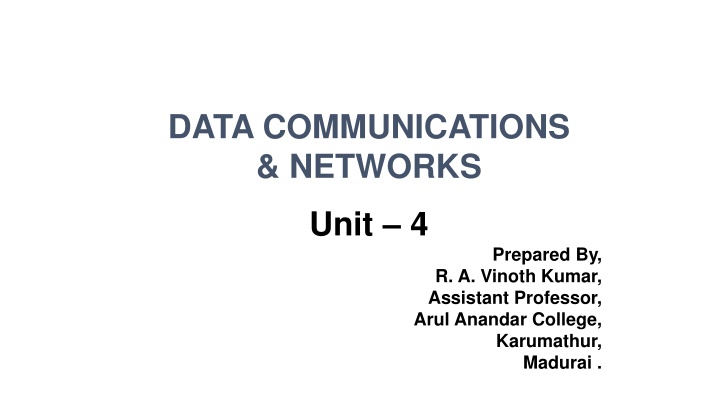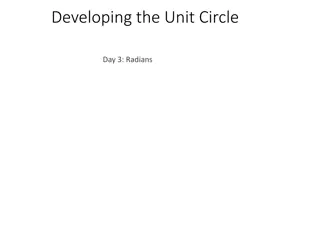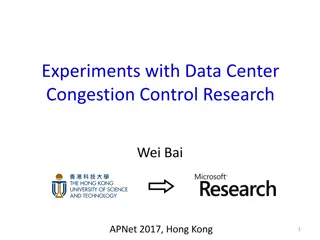
Data Communications & Networks: Devices and Functions
Explore the roles of devices like repeaters, hubs, and bridges in data communications and networks. Learn about their functions, types, and how they contribute to extending signal strength, connecting multiple devices, and filtering data efficiently. Discover the importance of these devices in maintaining network integrity and performance.
Download Presentation

Please find below an Image/Link to download the presentation.
The content on the website is provided AS IS for your information and personal use only. It may not be sold, licensed, or shared on other websites without obtaining consent from the author. If you encounter any issues during the download, it is possible that the publisher has removed the file from their server.
You are allowed to download the files provided on this website for personal or commercial use, subject to the condition that they are used lawfully. All files are the property of their respective owners.
The content on the website is provided AS IS for your information and personal use only. It may not be sold, licensed, or shared on other websites without obtaining consent from the author.
E N D
Presentation Transcript
DATA COMMUNICATIONS & NETWORKS Unit 4 Prepared By, R. A. Vinoth Kumar, Assistant Professor, Arul Anandar College, Karumathur, Madurai .
1. Repeater A repeater operates at the physical layer. Its job is to regenerate the signal over the same network before the signal becomes too weak or corrupted so as to extend the length to which the signal can be transmitted over the same network. An important point to be noted about repeaters is that they do not amplify the signal. When the signal becomes weak, they copy the signal bit by bit and regenerate it at the original strength. It is a 2 port device.
2. Hub A hub is basically a multiport repeater. A hub connects multiple wires coming from different branches, for example, the connector in star topology which connects different stations. Hubs cannot filter data, so data packets are sent to all connected devices. In other words, collision domain of all hosts connected through Hub remains one. Also, they do not have intelligence to find out best path for data packets which leads to inefficiencies and wastage.
Types of Hub Active Hub:- These are the hubs which have their own power supply and can clean, boost and relay the signal along with the network. It serves both as a repeater as well as wiring centre. These are used to extend the maximum distance between nodes. Passive Hub :- These are the hubs which collect wiring from nodes and power supply from active hub. These hubs relay signals onto the network without cleaning and boosting them and can t be used to extend the distance between nodes. Intelligent Hub :- It work like active hubs and include remote management capabilities. They also provide flexible data rates to network devices. It also enables an administrator to monitor the traffic passing through the hub and to configure each port in the hub.
3. Bridge A bridge operates at data link layer. A bridge is a repeater, with add on the functionality of filtering content by reading the MAC addresses of source and destination. It is also used for interconnecting two LANs working on the same protocol. It has a single input and single output port, thus making it a 2 port device.
Types of Bridges Transparent Bridges:- These are the bridge in which the stations are completely unaware of the bridge s existence i.e. whether or not a bridge is added or deleted from the network, reconfiguration of the stations is unnecessary. These bridges make use of two processes i.e. bridge forwarding and bridge learning. Source Routing Bridges:- In these bridges, routing operation is performed by source station and the frame specifies which route to follow. The hot can discover frame by sending a special frame called discovery frame, which spreads through the entire network using all possible paths to destination.
4. Switch A switch is a multiport bridge with a buffer and a design that can boost its efficiency(a large number of ports imply less traffic) and performance. A switch is a data link layer device. The switch can perform error checking before forwarding data, that makes it very efficient as it does not forward packets that have errors and forward good packets selectively to correct port only. In other words, switch divides collision domain of hosts, but broadcast domain remains same.
5. Routers A router is a device like a switch that routes data packets based on their IP addresses. Router is mainly a Network Layer device. Routers normally connect LANs and WANs together and have a dynamically updating routing table based on which they make decisions on routing the data packets. Router divide broadcast domains of hosts connected through it.
5. Gateway A gateway, as the name suggests, is a passage to connect two networks together that may work upon different networking models. They basically work as the messenger agents that take data from one system, interpret it, and transfer it to another system. Gateways are also called protocol converters and can operate at any network layer. Gateways are generally more complex than switch or router.
Distance Vector Routing Algorithm The Distance vector algorithm is iterative, asynchronous and distributed. Distributed: It is distributed in that each node receives information from one or more of its directly attached neighbors, performs calculation and then distributes the result back to its neighbors. Iterative: It is iterative in that its process continues until no more information is available to be exchanged between neighbors. Asynchronous: It does not require that all of its nodes operate in the lock step with each other. The Distance vector algorithm is a dynamic algorithm. It is mainly used in ARPANET, and RIP. Each router maintains a distance table known as Vector.
Three Keys to understand the working of Distance Vector Routing Algorithm: Knowledge about the whole network: Each router shares its knowledge through the entire network. The Router sends its collected knowledge about the network to its neighbors. Routing only to neighbors: The router sends its knowledge about the network to only those routers which have direct links. The router sends whatever it has about the network through the ports. The information is received by the router and uses the information to update its own routing table. Information sharing at regular intervals: Within 30 seconds, the router sends the information to the neighboring routers.
Link State Routing Link state routing is the second family of routing protocols. While distance vector routers use a distributed algorithm to compute their routing tables, link-state routing uses link-state routers to exchange messages that allow each router to learn the entire network topology. Based on this learned topology, each router is then able to compute its routing table by using a shortest path computation. Features of link state routing protocols Link state packet A small packet that contains routing information. Link state database A collection information gathered from link state packet. Shortest path first algorithm (Dijkstra algorithm) A calculation performed on the database results into shortest path Routing table A list of known paths and interfaces.
Link State protocols in comparison to Distance Vector protocols: 1. It requires large amount of memory. 2. Shortest path computations require many CPU circles. 3. If network use the little bandwidth ; it quickly reacts to topology changes 4. All items in the database must be sent to neighbors to form link state packets. 5. All neighbors must be trusted in the topology. 6. Authentication mechanisms can be used to avoid undesired adjacency and problems. 7. No split horizon techniques are possible in the link state routing.






















